The Flöge Family
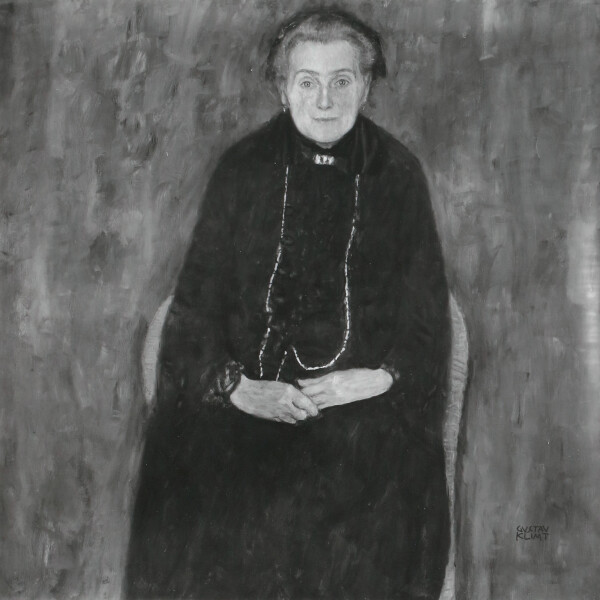
Gustav Klimt: Portrait of Barbara Flöge, 1917/18, private collection
© Gallery Welz Salzburg
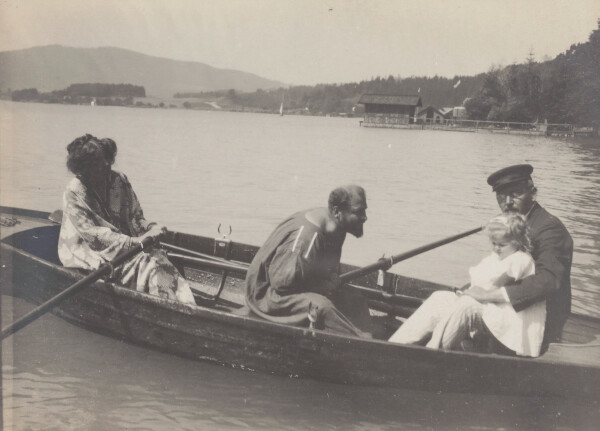
Gustav Klimt and the Flöges in a rowing boat on Lake Attersee in front of Villa Paulick, summer 1909, Klimt Foundation
© Klimt Foundation, Vienna
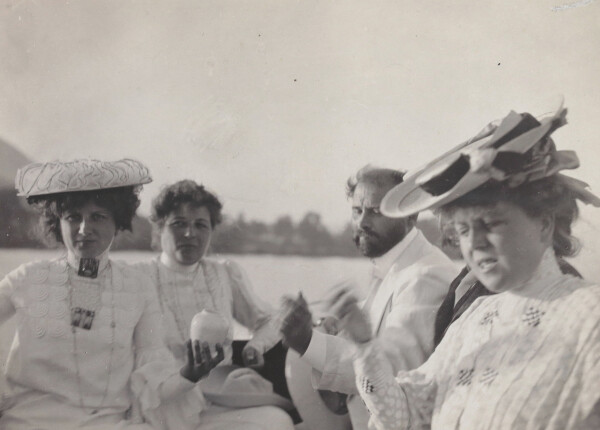
Gustav Klimt with the Flöge sisters in Paul Bacher's motorboat "Namenlos" on Lake Attersee, summer 1905, Klimt Foundation
© Klimt Foundation, Vienna
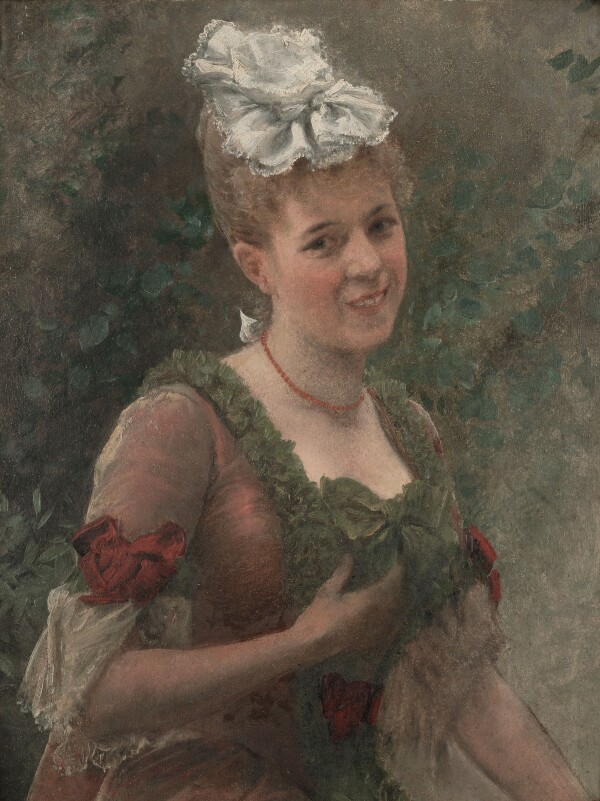
Gustav Klimt: Pauline Flöge in a Rococo Costume, 1892-1894, ARGE Sammlung Gustav Klimt, Dauerleihgabe im Leopold Museum, Wien, Permanent Loan, Leopold Museum, Vienna
© Leopold Museum, Vienna
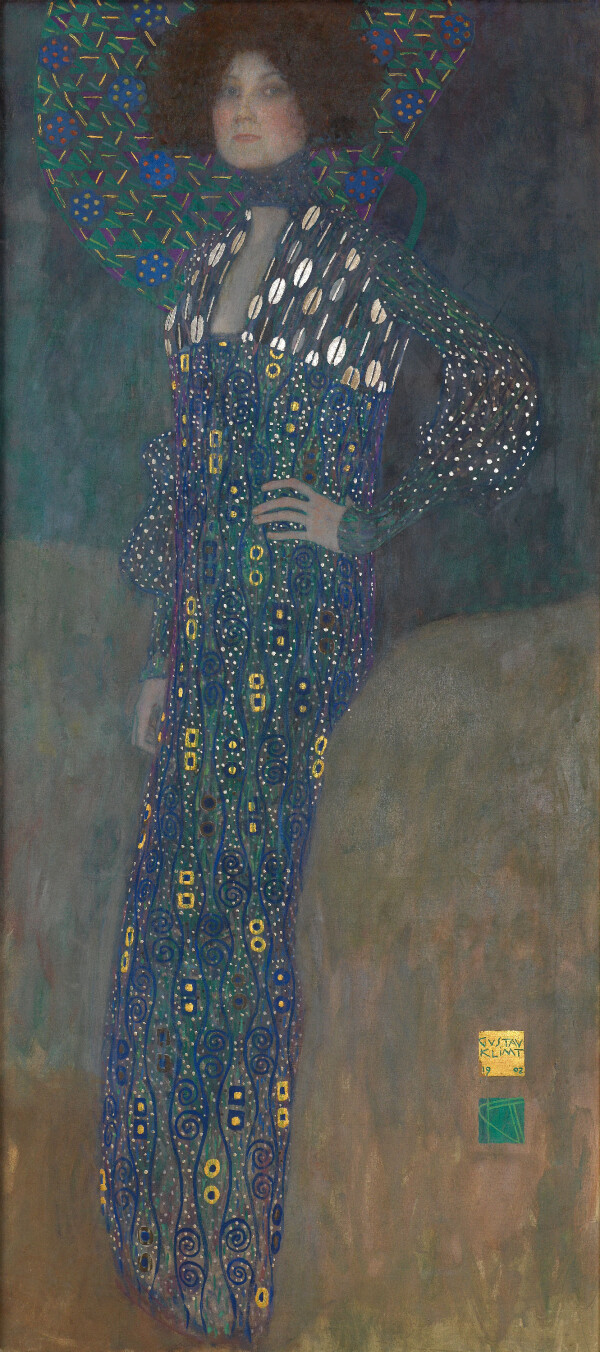
Gustav Klimt: Portrait of Emilie Flöge, 1902/03, Wien Museum
© Wien Museum
For Gustav Klimt, the Flöge family meant not only kinship and friendship. It was above all the relationship with Emilie Flöge that was to mold him as a person and artist throughout his life.
Hermann and Barbara Flöge
Hermann August Flöge, born in Vienna on 25 February 1837, followed in his father’s footsteps and became a master wood turner. He specialized in the production of meerschaum pipes. At the 1873 Vienna World’s Fair, his products were awarded a “Medal of Progress.” In 1862 he married Barbara (née Stagl), born in Vienna on 20 November 1840 as the daughter of master builder Benedikt Stagl. They had six children, two of whom, Rudolf and Hermine, died when still infants.
Hermann Flöge died on 28 December 1897. With his Portrait of Hermann Flöge sen. on His Deathbed (1899/1900, Belvedere, Vienna), Gustav Klimt paid his last artistic respects to him. Shortly before the artist’s own death, he also captured Barbara in oil on canvas in the painting Portrait of Barbara Flöge (1917/18, private collection). She died on 27 February 1927.
Hermann, Therese, and Gertrude Flöge
The family’s first son, Hermann Benediktus Flöge, was born on 14 March 1863. From 1888 to his death on 4 March 1916, he worked as an accountant and registered manager at the Vienna subsidiary of the Dornbirn-based textile company Herrburger & Rhomberg. The company also appreciated the artistic inspirations he provided for the patterning of their colored fabrics. In 1906, Hermann married Therese Paulick. On 16 December 1907, Gertrude “Trudl” Flöge came into the world. Klimt drew several portrait sketches of little Getrude. In addition, snapshots in the rowing boat and on the landing stage of Villa Paulick in Seewalchen made in summer 1909 and spring 1913 document Klimt’s close familiarity with Gertrude and her parents. Following the death of her mother Therese in 1949, Gertrude inherited the historical lakeside villa in Upper Austria, which had been an inspiration for Klimt during seventeen summers. Gertrude Flöge died on 28 July 1971.
Pauline Flöge
Born in Vienna on 21 December 1866, Pauline Magdalena Flöge trained as a dressmaker. In 1895 she opened a private dressmaking school. She was also portrayed by Klimt, such as in the painting Pauline Flöge in a Rococo Costume (1892–1894, ARGE Sammlung Gustav Klimt). In 1904 she gave up her position as a teacher and founded her own fashion salon together with her sisters Helene and Emilie. She was in charge of the office and saw to administrative matters. Pauline died on 3 July 1917. Klimt portrayed her on her deathbed, but this work is believed to have burned in 1945.
Helene (née Flöge), Ernst, and Helene “Lentschi” Klimt
Helene Anna Flöge, who was born in Vienna on 20 May 1871, married Gustav’s brother Ernst on 7 September 1891. Their union, despite its briefness due to Ernst’s unexpected death on 9 December 1892, not only led to Gustav Klimt’s encounter with his lifelong companion and soulmate Emilie Flöge, but also established Klimt’s deep bond with the Flöge family. Klimt would act as a guardian for their daughter Helene “Lentschi” Emilie Klimt (married name Donner), who was born on 28 July 1892. He captured his six-year-old niece, for whom he always cared like a father, in Portrait of Helene Klimt (1898, private collection). Until her death on 27 January 1936, her mother Helene worked at the fashion salon she had established together with her sisters. She was responsible for customer relations. Her daughter “Lentschi” was also supposed to join the family business. Klimt's niece went to an art school for woman and girls for a year. In October 1910 she inscripted at the k. k. Kunstgewerbeschule where she was instructed by Rosalia Rothansel in a special course for textile art and took ornamental drawing, taught by Franz Cizek, as a secondary subject. Afterwards she was taught enamel art by Adele Stark until 1913.
On 25 June 1921, Helene “Lentschi” married bank director Dr. Rudolf Donner. After her husband’s premature death she lived with her Aunt Emilie and spent countless summers on the Attersee. Helene “Lentschi” Donner died on 5 January 1980.
Emilie Flöge and Gustav Klimt
Born on 30 August 1874, Emilie Louise Flöge was the youngest daughter of Hermann and Barbara Flöge. Together with her sisters Pauline and Helene, she ran the fashion salon called “Schwestern Flöge,” which had opened on 1 July 1904 on premises designed by the Wiener Werkstätte on Vienna’s Mariahilfer Straße, acting as the salon’s artistic director. She was Klimt’s close confidante and companion. The two of them spent many summers on the Attersee together. Around 1892, Gustav portrayed the future fashion designer and businesswoman in Emilie Flöge in a Rococo Costume (1892–1894, private collection). What is probably Klimt’s most famous portrait of her dates from 1902/03. He presented his painting Portrait of Emilie Flöge (1902/03, Wien Museum, Vienna) at the “Kunstschau Wien 1908,” where it was acquired by the Lower Austrian State Council. The once-in-a-century artist wrote about the event in a postcard of 6 July 1908 to Emilie Flöge, who already sojourned on the Attersee:
“Today you are going to be ‘sold off’ respectively ‘cashed’ [...].”
A myriad of picture postcards from Klimt to Emilie grant insights into their relationship, which was marked by mutual respect and inspiration. Emilie’s replies have not survived. On 30 December 1917, Klimt, staying with the Primavesi family in Winkelsdorf, wrote his last letter to Emilie, who had remained in Vienna, wishing her “the happiest New Year ever – which the two of us do need so very urgently.”
Just a few days later he suffered a cerebral stroke. Klimt passed away on 6 February 1918. After his death, his estate was divided up amongst a community of heirs. Helene “Lentschi” Klimt and Emilie also received their shares. Emilie kept the items she had inherited, such as pieces from Klimt’s collection of Asian art and from his inventory of costumes, as well as paintings and drawings, in the reception rooms of the Casa Piccola, in the so-called “Klimt Room.” Among other pictures, the master’s last monumental painting The Bride (1917/18 [unfinished], Klimt-Foundation, Vienna), which had remained unfinished, had also passed into Flöge’s possession. In 1938, following the closedown of their fashion salon, Emilie and Helene moved to Ungargasse 39 in Vienna’s 3rd district with all their belongings. The entire part of Klimt’s estate that was kept there fell victim to fire in 1945, when the apartment suffered war damage. Emilie Flöge died on 26 May 1952.
Literature and sources
- Ansichtskarte von Gustav Klimt in Wien an Emilie Flöge in Kammer am Attersee, 2. Karte (Morgen) (07/06/1908).
- Ansichtskarte mit Kuvert von Gustav Klimt in Winkelsdorf an Emilie Flöge in Wien, DLSTPW12 (12/30/1917), .
- Sandra Tretter, Peter Weinhäupl (Hg.): Gustav Klimt. Emilie Flöge. Reform der Mode. Inspiration der Kunst, Vienna 2016.
- Wolfgang Georg Fischer: Gustav Klimt und Emilie Flöge. Genie und Talent, Freundschaft und Besessenheit, Vienna 1987.
- Wolfgang Georg Fischer: Gustav Klimt und Emilie Flöge III. Erinnerungen an Emilie Flöge, in: Alte und moderne Kunst. Österreichische Zeitschrift für Kunst, Kunsthandwerk und Wohnkultur, 26. Jg., Heft 190/191 (1983), S. 57.

